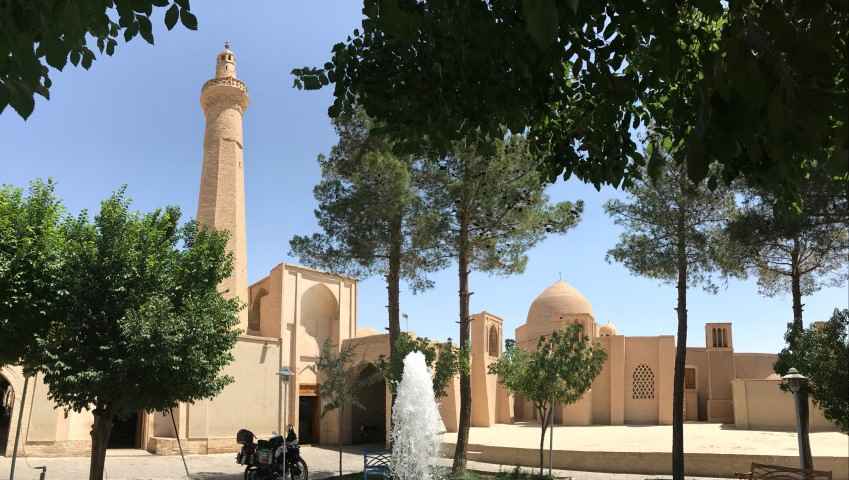Nain
A historical gem that offers interesting historical sites and wonderful knots for pesian carpet lovers. Nain, located on the edge of the Lut desert in the province of Isfahan, has some quite remarkable monuments, such as the 10th century Jomeh Mosque, one of the first four mosques built in Iran after the Arab invasion, the pre-Islamic fortress from Narej, the traditional house of the Pirnias and the old bazaar. The particularity of this city is the use of the “Ab Anbar”, traditional drinking water reservoirs in Iran. This city is also famous for its high-quality silk rugs and fine camel wool fabrics.
Antiquities of Nain
Jomeh Mosque
It has an architecture skillfully synthesized by creative thinking, the majesty and splendor of the interior spaces. The 28 m high octagonal minaret was added to the mosque about 700 years ago. The basement is used as a prayer room during hot summers and cold winters, the temperature of which is always moderate and variable up to 15 degrees.
The basement was simply dug into the ground, that is, without having used materials in its construction. The alabaster stone on the floor of the mosque courtyard reflects the warm and bright sunlight into the basement, which is itself illuminated by natural light. The patio is surrounded by 14 columns, each one decorated with magnificent bricks of different geometric shapes, creating a perfect harmony at first glance.
Beneath the mosque is another masterpiece of the Iranian engineers who once built the Kariz, the Qanat: it is an aqueduct canal carrying water from the underground springs of the surrounding mountains and passing through a series of channels dug under the city, which allows the inhabitants to supply the required water from the vicinity. The Kariz system is a typical Middle Eastern construction whose history dates back several thousand years in Iran.
The staircase to the basement led to the channel that passed under the mosque, which allowed water to be introduced into it to facilitate the ablution ritual.
Narenj fortress
Narenj Fortress is what remains of a structure also known as Narin Castle. The materials used in the castle, as well as its architectural style, support the idea that it was built in pre-Islamic times. According to research, this monument belongs to the Parthian period. The castle is located near the mosque and connects the old bazaar from the 14th century AD., today in disuse, with the mosque itself.
Nain Bazaar
The bazaar stretches 340 m along a curved line from the Chehel Dokhtaran gate to the Khajeh Khezr mosque and is connected by alleys and main passages leading to the centers of the district. The bazaar has two passages. One part of the bazaar has been renovated, and the other is no longer in use.
Traditional house of Pirnia
The traditional house of Pirnia is a perfect example of the desert houses of this region in terms of architecture and art. The house consists of an exterior, an interior, a garden, a silo and all the necessary facilities for the house at that time. As we entered the house and crossed the first corridor, we came to an octagonal room called hashtí, which was the waiting room for clients and visitors. Beautiful paintings of Koranic stories, books of famous poems, and exquisite calligraphy decorate the room. Today, this house is used as an anthropological museum in which the history, culture and lifestyle of its inhabitants are exhibited. The museum also offers the possibility of knowing the Klim fabrics and others made with the machines of the time in the museum.
Aba bafi, the Caves of the Weavers of the Religious Habit
In Mohammadieh, there are some man-made caves called Sardab-e Aba bafi by the locals. Evidence shows that they were excavated by the Zoroastrians who lived there. The Zoroastrians abandoned them, and the Muslim inhabitants used them as workshops to weave coats and prayer rugs. Manual coat weaving is one of Nain’s most valuable historical arts and crafts. Some of the workshops are 700 years old.
Old Rigareh
In the district of Mohammadieh there is a mill that works with water from Kariz. The age of this engineering masterpiece is unknown, but some historians believe it dates back to pre-Islamic times. The water comes from the Keykhosrow canal and the mill is located 28 meters below ground. The access corridor to the mill has a length of about 133 m. A channel runs nine meters above the mill and fills the huge water tank with a diameter of 9 meters. When enough pressure is available, the water is released and turns the turbine.
If you are passionate about anthropology, historical landscapes and fascinating culture of the Middle East, SITO Travel will help you organize your trip to Iran. Contact us because our experience is born and developed in the field.



Comments